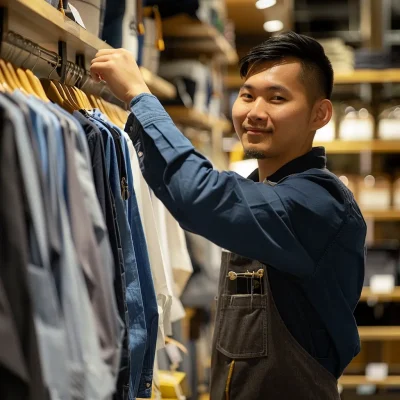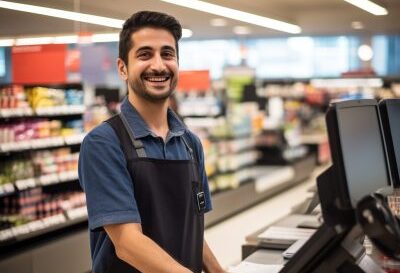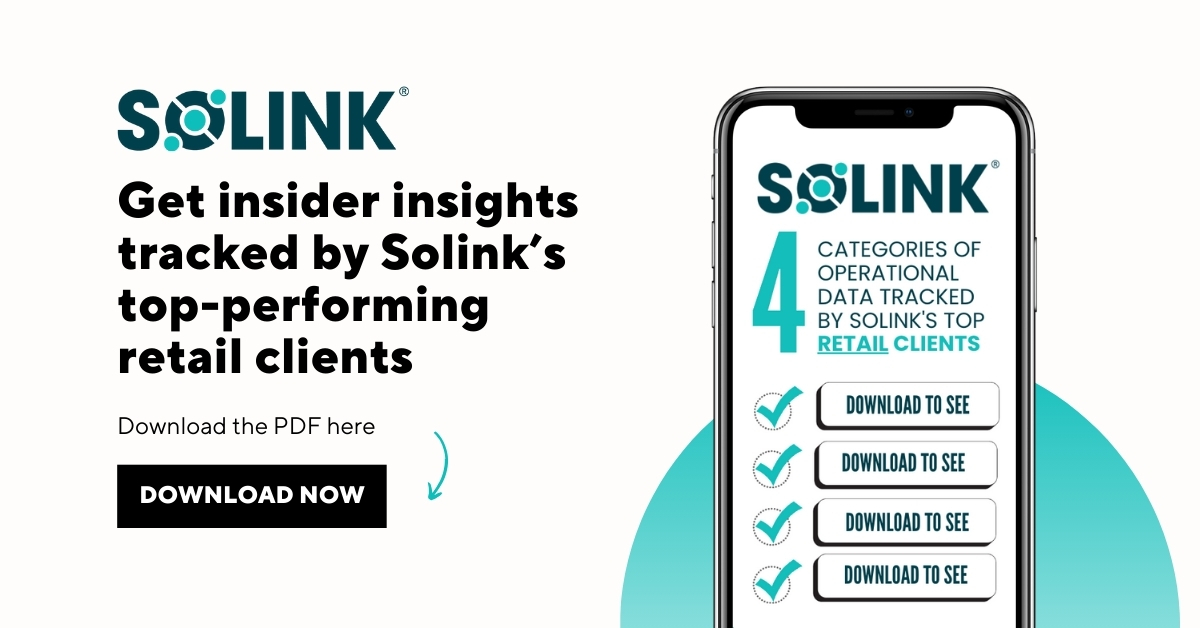Table of Contents
Table of Contents
Keeping your retail store safe is just as important as making sales. From preventing theft to ensuring a secure shopping environment, strong safety guidelines protect both customers and employees. Slips, falls, theft, and workplace accidents can lead to costly losses and legal issues.
In this guide, we’ll cover essential safety practices every retailer should follow, including store security, emergency preparedness, and loss prevention strategies. A safer store means happier customers, protected employees, and a stronger bottom line. See how Solink can help your retail business.
In this guide, we’ll cover essential safety practices every retailer should follow, including store security, emergency preparedness, and loss prevention strategies. A safer store means happier customers, protected employees, and a stronger bottom line. See how Solink can help your retail business.

Why your retail store needs written safety guidelines
Safety isn’t just about avoiding accidents; it’s about creating an environment of trust and reliability for both staff and customers. Without proper health and safety measures, the consequences can be severe:
- Lost business: A reputation for being unsafe can deter customers. This is especially an issue with organized retail theft.
- Financial penalties: Fines can be imposed for safety breaches.
- Litigation risks: Lawsuits from injured parties can cost millions.
- Employee turnover: A hazardous environment can lead to higher staff turnover.
- Decreased productivity: Constant accidents can reduce operational efficiency.
- Insurance premium hikes: More claims can lead to higher insurance costs.
Maintaining a safe shopping environment for customers
A safe shopping environment keeps customers comfortable and reduces the risk of accidents or security incidents. Simple steps like keeping aisles clear, ensuring proper lighting, and promptly cleaning up spills can prevent injuries. Clear signage for exits, restrooms, and hazard areas also improves safety.
Security measures, such as visible surveillance cameras and attentive staff, help deter theft and suspicious activity. Having a well-trained team that knows how to handle emergencies—whether it’s a medical issue, fire, or security threat—ensures quick responses and minimizes risks.
By prioritizing cleanliness, organization, and security, retailers create a safer, more welcoming shopping experience for everyone.
Security measures, such as visible surveillance cameras and attentive staff, help deter theft and suspicious activity. Having a well-trained team that knows how to handle emergencies—whether it’s a medical issue, fire, or security threat—ensures quick responses and minimizes risks.
By prioritizing cleanliness, organization, and security, retailers create a safer, more welcoming shopping experience for everyone.
How your security camera system can help
A security camera system should do more than just record footage—it should actively help ensure compliance, and improve safety. With Solink, retailers get an AI-powered security solution that not only monitors transactions but also automates safety and compliance checks to keep stores running smoothly.
Employees without required PPE (hard hats, gloves, safety vests)
Blocked emergency exits that violate safety codes
Spills or trip hazards that could lead to accidents or fines
“Before Solink, it was impossible for me to check all 40 stores regularly. Now, AI Spot Check automatically monitors for safety compliance. If someone isn’t wearing PPE or there’s an oil spill, I get a notification and can have it fixed immediately. It’s been life-saving and life-changing.”
— Remondo Pitts, Director of Security, Surveillance and Loss Prevention, Pull-A-Part
Instead of manually reviewing hours of footage, Solink instantly flags safety concerns, allowing managers to act quickly and prevent costly violations.
Beyond security, Zone Tracking also ensures compliance with safety regulations and company policies. By monitoring restricted zones, retailers can verify that employees are following procedures, such as wearing required uniforms or keeping emergency exits clear. Solink’s real-time alerts and cloud-based video access make it easy to address violations immediately, preventing accidents and ensuring a safe, compliant workplace for both staff and customers.
Ensure safety and compliance with AI-powered spot checks
Keeping a retail store compliant with safety regulations can be a challenge, especially for businesses with multiple locations. Solink’s AI Spot Check takes the guesswork out of compliance by automatically scanning video footage for potential violations, such as:Employees without required PPE (hard hats, gloves, safety vests)
Blocked emergency exits that violate safety codes
Spills or trip hazards that could lead to accidents or fines
“Before Solink, it was impossible for me to check all 40 stores regularly. Now, AI Spot Check automatically monitors for safety compliance. If someone isn’t wearing PPE or there’s an oil spill, I get a notification and can have it fixed immediately. It’s been life-saving and life-changing.”
— Remondo Pitts, Director of Security, Surveillance and Loss Prevention, Pull-A-Part
Instead of manually reviewing hours of footage, Solink instantly flags safety concerns, allowing managers to act quickly and prevent costly violations.
Beyond security, Zone Tracking also ensures compliance with safety regulations and company policies. By monitoring restricted zones, retailers can verify that employees are following procedures, such as wearing required uniforms or keeping emergency exits clear. Solink’s real-time alerts and cloud-based video access make it easy to address violations immediately, preventing accidents and ensuring a safe, compliant workplace for both staff and customers.
Best safety guidelines for retail stores you should implement today
In today’s retail landscape, safety is not just a priority; it’s a necessity. Both employees and customers step into a store with the implicit trust that their well-being is accounted for. Yet, often, safety measures are reactive, implemented after an unfortunate event rather than as a proactive strategy. This approach can lead to a compromised reputation, loss of trust, and even financial ramifications.
The following 60 safety guidelines for retail stores serve as a comprehensive checklist for retailers aiming to elevate their safety protocols. Whether you’re a small boutique or a large retail chain, these retail safety best practices cater to varied retail environments, ensuring a seamless shopping experience while protecting the business’s most valuable assets: its people and its reputation.
Employee safety and training
Employees are the cornerstone of any retail establishment. Their safety and well-being directly influence the store’s functionality and customer satisfaction. By prioritizing comprehensive training and adopting safety measures tailored for staff, retailers not only ensure a safe working environment but also boost employee morale and efficiency.
- Employee training: Regular employee training is essential for maintaining a safe retail environment. Staff should be trained on emergency procedures, theft prevention, and proper safety protocols to reduce risks and improve response times.
- Footwear policy: Non-slip shoes can prevent many in-store accidents.
- Safe use of equipment: Proper training ensures tools are used without causing harm.
- Safe handling techniques: Safe handling techniques help prevent injuries and ensure smooth store operations. Employees should be trained on proper lifting methods to avoid strain, especially when handling heavy stock. Using tools like dollies and step stools instead of overreaching or carrying excessive weight reduces the risk of accidents.
- Personal protective equipment: Employees should be provided with essential gear to guard against specific hazards and trained on when protective equipment must be used.
- Rest breaks: Regular breaks prevent fatigue-related accidents.
- Ongoing safety training: Refreshers keep safety protocols top-of-mind.
- Safe use of chemicals: Proper handling and storage of chemicals are essential for maintaining a safe retail environment. Employees should be trained on how to use cleaning products, disinfectants, and other chemicals according to manufacturer guidelines.
Physical store safety
The physical layout and infrastructure of a store play a pivotal role in ensuring both customer and employee safety. Properly maintained facilities, clear pathways, and strategic product placements minimize potential hazards. A store that prioritizes its physical safety often sees increased customer trust and fewer incidents.
- Emergency exits: Keeping emergency exits clear and accessible at all times is crucial for workplace safety. Employees should be trained on emergency evacuation procedures and know the locations of all exit routes.
- Fire safety: Fire safety in retail stores starts with prevention and preparedness. Employees should be trained on how to use fire extinguishers, identify fire hazards, and follow emergency evacuation plans.
- Shelving stability: Proper shelving stability is essential to prevent accidents and ensure a safe shopping environment. Shelves should be securely anchored and regularly inspected for signs of wear, damage, or overloading. Heavy items should be placed on lower shelves to reduce tipping risks, and employees should follow proper stocking procedures to maintain balance and organization. Keeping shelving units stable helps protect both customers and employees from potential hazards.
- Product placement: Organize products ensuring ease of access and minimal risk. The same thought should be given to organizing the stockroom.
- Good lighting: Good lighting is essential for both safety and security in a retail store. Well-lit aisles, stockrooms, and entryways help prevent trips and falls while also deterring theft.
- Safety barriers: Safety barriers help protect employees and customers by clearly defining restricted areas and preventing accidents. They can be used to block off wet floors, secure stockroom entrances, or create safe pathways in high-traffic areas.
- Ventilation: Proper ventilation is essential for maintaining air quality and creating a safe, comfortable shopping environment. Good airflow helps reduce the buildup of dust, odors, and potentially harmful fumes from cleaning chemicals or storage areas. Regular maintenance of HVAC systems ensures efficient operation.
- Temperature control: Comfortable temperatures reduce health risks and increase shopper comfort.
- Electrical safety: Electrical safety is crucial in preventing fires, power failures, and workplace injuries. Employees should be trained to recognize and report frayed wires, overloaded outlets, or malfunctioning equipment. Regular inspections and maintenance of electrical systems help identify potential hazards before they become serious.
- Clear exit paths: Unobstructed routes enhance safety during emergencies. Use Solink’s Blocked Exit Detection to make sure your exits are always clear.
- Secure fixtures: Firmly fixed store fixtures prevent accidents.
- Anti-trip measures: Flat surfaces and secured cords mean fewer tripping incidents.
Security and monitoring
In an era where security challenges are ever-evolving, robust security systems and security protocols are essential. These measures deter potential threats, ensure asset protection, and provide peace of mind to both patrons and staff. A store that’s securely monitored is a store where business thrives.
- Solink’s cloud video security: Solink’s cloud video security provides retailers with real-time monitoring, remote access, and AI-powered insights to enhance safety and security. By integrating video security with transaction data, Solink helps businesses quickly identify theft, policy violations, and safety risks. With secure cloud storage, footage is always accessible, eliminating the risk of lost or damaged recordings. Retailers can track incidents, receive instant alerts, and review footage from anywhere, ensuring a safer environment for both employees and customers.
- Secure cash handling: Drop boxes and timed safes limit exposure to theft. Be sure to write a cash handling policy so every associate understands the proper procedures.
- Anti-theft devices: Electronic tags act as deterrents for potential shoplifters.
- Security personnel: On-site security can quickly address safety and theft concerns. Remote guarding can also be used, as it is often more effective at a much lower cost.
- Access control: Restricting certain areas ensures only authorized personnel can enter.
- CCTV monitoring: With Solink’s system, review past footage to assess and rectify safety lapses. Remote video monitoring is an important part of multi-unit retail health and safety operations.
- Panic buttons: Quick communication tools like panic buttons and duress buttons for staff during emergencies.
- Parking lot safety: A well-lit and patrolled parking area ensures customer and employee safety.
Health and cleanliness
Cleanliness is closely linked to health. A retail environment that emphasizes cleanliness not only enhances the shopping experience but also ensures that health risks are minimized. Regular sanitation, pest control, and cleanliness protocols reflect a store’s commitment to its patrons’ well-being.
- Spill protocol: A clear spill protocol helps prevent slips, falls, and injuries in a retail environment. Employees should be trained to address spills immediately by placing warning signs, cleaning the area thoroughly, and using the proper cleaning supplies for different surfaces.
- Safe storage: Proper storage of hazardous materials ensures no unintentional exposure.
- First aid: A stocked firs-aid kit and trained personnel can address minor injuries immediately.
- Hygiene practices: Maintaining proper hygiene practices in a retail store helps create a clean and safe environment for both employees and customers. Regular handwashing, sanitizing high-touch surfaces, and properly handling merchandise reduce the spread of germs.
- Pest control: Regular inspections and treatments ensure a clean store environment.
- Protective screens: Protective screens provide an added layer of safety by reducing the spread of germs and creating a barrier between employees and customers. They are especially useful at checkout counters, customer service desks, and other high-contact areas. Regular cleaning and proper installation ensure they remain effective without obstructing communication or transactions. Using protective screens helps maintain a healthier and safer shopping environment for everyone.
Emergency preparedness
Emergencies are unpredictable. However, how a retail store responds to such situations can be controlled with proper preparation. Emergency preparedness encompasses plans, drills, and tools necessary to tackle unforeseen events, ensuring minimal harm and a swift return to normalcy.
- Regular inspections: Periodic audits detect and rectify potential hazards.
- Safety signage: Visible signs provide guidance during emergencies.
- Report hazards: A system for staff to report safety concerns ensures timely action.
- Incident logs: Documenting incidents helps in understanding patterns and taking corrective measures.
- Emergency drills: Regular drills ensure everyone knows their roles during actual emergencies.
- Safety communication: Effective communication channels can be crucial during crises.
- Emergency contacts: Clearly displayed contacts ensure swift communication with emergency services.
- Monitor store capacity: Managing crowd size, especially during peak times, ensures safety and comfort.
Customer safety and experience
A customer’s experience is intricately tied to their sense of safety within the store. By creating an environment where customers feel secure, retailers can enhance their overall shopping experience, leading to increased loyalty and repeat business. Every safety measure indirectly contributes to a positive shopping experience.
- Crowd control: Effective crowd control ensures a safe and organized shopping environment, especially during peak hours or special events. Clear signage, designated entry and exit points, and properly staffed checkout areas help manage foot traffic and prevent congestion. Using barriers or floor markings can guide customers and reduce the risk of accidents or conflicts. Well-planned crowd control measures improve customer experience while maintaining safety for both shoppers and employees.
- Child safety: Child safety in retail stores is essential to prevent accidents and ensure a family-friendly environment. Stores should have clear policies to address lost children, including designated meeting points and trained staff to assist. Keeping aisles clear, securing heavy merchandise, and using child-friendly signage can help reduce risks.
- Customer assistance: Providing strong customer assistance enhances both safety and the overall shopping experience. Well-trained employees can help prevent accidents by guiding customers to products, assisting with heavy items, and addressing potential hazards like spills or obstacles. Clear signage and accessible help stations make it easy for customers to seek assistance when needed. A proactive approach to customer service not only improves satisfaction but also creates a safer retail environment.
- Feedback system: A feedback system helps retailers identify safety concerns and improve the overall shopping experience. Providing customers and employees with an easy way to report hazards, security issues, or operational concerns ensures that problems are addressed quickly. Digital surveys, suggestion boxes, or direct staff communication can all be effective feedback channels. Regularly reviewing and acting on feedback helps create a safer, more efficient retail environment.
Data and transactional safety
In our digital age, data breaches and transactional frauds are significant concerns for retailers. Protecting sensitive data, ensuring secure transactions, and maintaining customer trust are paramount. Retailers need to invest in robust systems to safeguard against these modern threats.
- Integrate POS data into Solink: Detect unusual transaction patterns, enhancing loss prevention.
- Data protection: Safeguard sensitive data from breaches or theft.
- Save and share with Solink: Backup your important video clips in the Solink cloud forever and share it with anyone with one click. This helps with everything from training and loss prevention to case management.
- Mobile safety apps: Apps for staff to report safety or operational concerns ensure quick action.
Operational best practices
Beyond immediate safety and security measures, the overall operations of a store must be rooted in best practices. This includes regular updates on safety protocols, feedback loops, and continuous training. Such practices ensure that the store remains compliant with regulations and is always ahead in its safety game.
- Regular updates: Stay abreast with local safety regulations.
- Safety committees: Dedicated teams can focus on enhancing store safety, ensuring consistent improvements.
- Feedback loop with staff: Encourage employees to provide feedback on operational and safety processes. Their on-the-ground perspective can offer invaluable insights.
- Continuous training: Beyond initial training sessions, offer continuous learning opportunities to keep staff updated on the latest safety protocols and equipment.
- Vendor and delivery protocols: Establish strict guidelines for vendors and deliveries, ensuring safe and organized receiving processes.
Solink keeps your people, patrons, and profits safe
Your retail store’s safety isn’t just about guidelines; it’s about leveraging technology that works proactively. Solink, an industry leader in security and business insights, brings advanced solutions like “Blocked Exit Detection.” This new product utilizes advanced AI video analytics to continuously ensure emergency exits are clear. Such a tool is indispensable in maintaining safety.
Not only does it ensure a safe evacuation route during emergencies, but it also shields businesses from the repercussions of hefty fines for blocked exits. By merging traditional safety guidelines with modern technology like that offered by Solink, retail stores can provide a secure environment for both employees and customers while safeguarding their bottom line.
To see how Solink is a partner in the safety of your retail business, sign up for a demo today.


